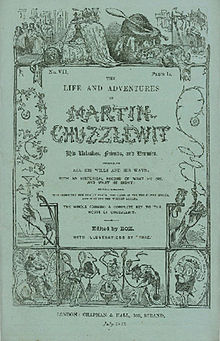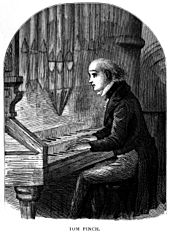Martin Chuzzlewit
The Life and Adventures of Martin Chuzzlewit , better known as Martin Chuzzlewit , is a novel by Charles Dickens and is considered the last of his picaresque novels . The novel appeared in several installments between 1843 and 1844. Dickens thought Martin Chuzzlewit was one of his best works, but it turned out to be one of his least popular novels. The sales success of the first sequels were disappointing compared to earlier works by Charles Dickens. In response, Dickens changed the plot and had the eponymous hero travel to America. This gave Dickens the opportunity to satirically portray the United States, which he had visited in 1842, as a wilderness in whose few more civilized places were predominantly deceitful profiteers.
The main theme of the novel is, according to the preface written by Dickens, the satirical depiction of selfishness, a trait that characterizes all members of the Chuzzlewit family. The novel is dedicated to Angela Georgina Burdett-Coutts , a friend and supporter of Dickens.
Johann Nestroy used Dickens' novel as a template for his farce Die liebe Anverwandten .
action
Young Martin Chuzzlewit is raised by his grandfather and namesake. This very wealthy man believes that everyone around him is after his money, so years before the novel began, he decided to raise a young orphan . Mary, this orphan, is supposed to be his carer in old age: as long as he lives she will be well looked after, but after his death she will be destitute. This is supposed to drive them to care for his well-being while his relatives benefit from his death. However, his grandson and heir Martin falls in love with Mary and ruins old Martin Chuzzlewit's plans with his marriage wish. He therefore demands of his grandson to break off the engagement and disinherits him when he fails to do so.
The young Martin Chuzzlewit becomes an apprentice to Mr. Pecksniff, an untalented greedy and hypocritical busybody who allegedly teaches young men architecture. In fact, he lives on her tuition fees and lets her make drawings that he claims to be his own. He has two vain, spoiled, and spiteful daughters, Mercy (Merry) and Charity (Cherry). It is not clear to the young Martin that Mr. Pecksniff is also one of his grandfather's relatives and that he wants to secure the goodwill of old Martin by taking in the grandson. The hope is that this benevolence will also find its expression in the will.
While he was living with the Pecksniffs, the young Martin met Tom Pinch. Pinch is a kind and kind hearted person whose late grandmother gave all of her possessions to Pecksniff because she believed that Pecksniff would make a great architect and gentleman out of her grandson. Pinch is so virtuous that he is unable to discern the true character of Pecksniff and defend him against others. While working for Pecksniff for exploitation wages, he believes that he is the unworthy recipient of Pecksniff's favors. John Westlock, Martin's predecessor as an apprentice at Pecksniff, immediately recognizes the true worth of Pinch and the wickedness of Pecksniff.
When old Chuzzlewit hears about his grandson's new life, he demands from Pecksniff that he throws the poor young Chuzzlewit out. Pecksniff immediately complies with this request. The old Chuzzlewit moves in with Pecksniff and slowly falls under his influence. During his stay, Pinch falls in love with Mary, but does not dare to confess his love to her, as he knows about her relationship with the young Chuzzlewit.
One of old Chuzzlewit's greedy relatives is his brother Anthony Chuzzlewit, who runs a business with his son Jonas. Although they have some wealth, they are stingy. Jonas can hardly wait for his father's death to get hold of the inheritance. Anthony Chuzzlewit eventually dies under suspicious circumstances, leaving his money to Jonas. Jonas initially advertises Cherry Pecksniff, who feels very flattered by it, while he constantly argues with Merry. However, Jonas suddenly ditched the angry Cherry and asked Seth Pecksniff for Merry's hand, not without demanding a dowry for the less popular Merry that was 1,000 pounds higher than the amount of 4,000 pounds initially granted him for Cherry. During their engagement, Merry teases him all the time, which Jonas patiently endures, pointing out that once they are married, he will have his revenge. Vengeance does happen. After getting married, he verbally and physically abuses Merry. Her personality changes from that of a giggling, fun-loving girl to that of a broken and scared woman. Cherry reacts with joy to Merry's suffering.
Jonas, meanwhile, learns the unscrupulous Montague Tigg know and becomes a partner of his fraudulent pyramid scheme . The character of Montague Tigg was introduced as a dirty little thief at the beginning of the novel. Here he still calls himself Tigg Montague and is the factotum of an equally questionable character named Chevy Slyme. After Tigg cheated young Chuzzlewit out of his valuable pocket watch and sold it, he bought elegant clothes, rented a classy office and changed his name. This facade is enough to fool investors into believing that he is an important businessman and that working with him will result in profitable business. So after depicting deceitful America, it turns out that the motherland is no better.
At this point in time Tom Pinch, who has worked for Pecksniff for several years, realizes the true character of his employer, because Mary admits his unwanted advances. Pecksniff becomes an ear-witness of the conversation and dismisses Tom Pinch. Pinch goes to London to look for work and becomes the savior of his sister Ruth, who is mistreated by her employers. The two set up a household and Tom Pinch meets John Westlock, who has now inherited rich. Pinch quickly gets a job with a mysterious employer with the help of the equally mysterious Mr. Fips.
The young Chuzzlewit has since become friends with Mark Tapley. Mark is always generous and cheerful, which in his opinion is only due to the fact that he is materially well. To check whether this character trait also marks him when his circumstances are less favorable, he decides to accompany the young Chuzzlewit as an unpaid servant when he sets off for the United States to try his luck there. In the United States they are trying to start a new existence in the swampy, sick place of Eden , where a crook has sold them land. Dickens uses this scene to make fun of the American character. What is also noticeable about these is that they always talk about bourgeois equality, but boast that they only socialized with the aristocracy on their trips to England. Mark and Martin nearly die of malaria they contract in Eden. The illness also changes Martin Chuzzlewit's proud and self-centered character. Martin Chuzzlewit wants to reconcile with his grandfather, who is now so under the control of Pecksniffs that he throws him out.
Pecksniff is included in the pyramid scheme through Jonas, who is blackmailed by Tigg. Only at the end of the novel does it become clear that Tigg has information that Jonas killed his father. After his return, the young Chuzzlewitt meets Tom Pinch again. At the same time, Jonas Chuzzlewit murders Montague Tigg when the pyramid scheme collapses to prevent him from using the information with which he blackmailed others. Tom Pinch discovers that old Martin Chuzzlewit is behind his mysterious employer. He reveals to him that he had seen how far greed can lead, using the example of Jonas and Anthony. He would have acted as if he were under the influence of Pecksniff, and quickly recognized the malevolence of Pecksniff and the strength of character of Pinch. Together they confront Pecksniff. They learn from Anthony's devoted servants that Jonas never killed his father. Jonas believes he poisoned him, but in fact his father died of a broken heart when he realized that his own son wanted him dead. Old Chuzzlewit also admits that the only reason he was so upset about the engagement between Martin and Mary was because he wanted to arrange the marriage himself. He realizes how foolish his annoyance is about it, and grandfather and grandson make up. Martin and Mary and Ruth Pinch and John Westlock get married. Mary remains Tom Pinch's secret love until the end of his life.
Characters
The character-rich novel also includes the character of Sairey Gamp or Sarah Gamp , whom Dickens portrays as incompetent, negligent, addicted to alcohol and corrupt. She works as a nurse, midwife and corpse washer. Even in a house of mourning, Sairey Gamp manages to make use of all the advantages of the house, regardless of who she actually has to take care of. During her nursing period, she regularly refers to a Mrs. Harris, a person she invented, with whom she has mock dialogues on all sorts of subjects, but which always end with Mrs. Harris congratulating her on her outstanding personality. The model of Dickens' character was the carer who temporarily looked after a sick servant in the household of his sponsor and friend Angela Burdett-Coutts . Dickens' depiction felt his readers as so aptly that the black umbrella, the Sairey Gamp habitually carries around with him, the colloquial term Gamp developed. Indeed, most of the nurses who worked in British hospitals in the first half of the 19th century were ex-servants or widows who could not find other employment and were therefore forced to make a living from that work . The reputation of the nurses who cared for the sick in their homes was no better. In fact, many of the nurses were drunk and it was common practice to give the nurses alcoholic beverages or money for their purchase as thanks for their services. The reputation that nurses who worked during the night in particular also fulfill the sexual wishes of their patients put the profession close to prostitution .
Single receipts
- ^ Hardwick, Michael and Mary Hardwick. The Charles Dickens Encyclopedia. New York: Scribner, 1973.
- ↑ Mark Bostridge: Florence Nightingale . Penguin Books, London 2009, ISBN 978-0-140-26392-3 , p. 94
- ↑ Mark Bostridge: Florence Nightingale . Penguin Books, London 2009, ISBN 978-0-140-26392-3 , pp. 96-98.




